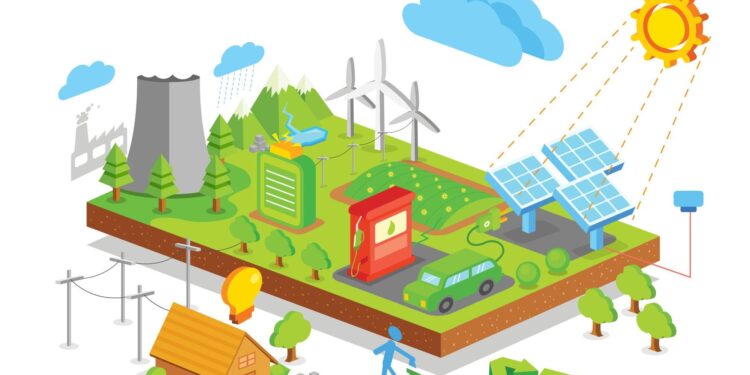Introduction: The Green Dilemma – Balancing Economic Growth with Environmental Responsibility
In the face of escalating climate change challenges, the global call for sustainable practices has surged across multiple industries. From initiatives aimed at achieving carbon neutrality to advancements in green technology, the commitment to environmental responsibility is at an all-time high. Yet, amidst this enthusiasm for eco-friendly policies, a crucial question emerges: can we be too committed to going green? This article explores the delicate equilibrium between economic advancement and ecological conservation, highlighting how an excessive emphasis on sustainability may lead to unexpected issues like economic instability and social disparities. Through case studies and expert insights, we will unravel the complexities that surface when striving for a greener future intersects with the practical demands of maintaining economic health. Join us as we engage in this vital conversation about forging a sustainable path that honors both our planet and its inhabitants.
Harmonizing Economic Expansion with Ecological Responsibility
As nations around the globe pursue rapid growth, understanding how economic development interacts with environmental integrity has become increasingly important. Lawmakers are tasked with crafting policies that not only stimulate growth but also safeguard natural ecosystems. Transitioning towards a more sustainable economy often requires significant investments in renewable energy technologies and resource-efficient methodologies. Essential strategies include:
- Investment in Renewable Energy Sources: Shifting from traditional fossil fuels to alternatives such as solar power, wind energy, and hydropower.
- Promotion of Sustainable Farming Practices: Advocating methods that reduce ecological impact while ensuring food security.
- Improvement of Public Transit Systems: Lowering carbon emissions by enhancing accessibility through electric transportation options.
Nevertheless, overly aggressive environmental regulations can hinder economic opportunities leading to job losses and stagnation. It is essential to find a balance that fosters sustainable growth, while also prioritizing ecological stewardship. To assess progress toward these dual aims effectively, consider the following table which outlines various initiatives along with their advantages and potential drawbacks:
| Initiative | Advantages | Pitfalls |
|---|---|---|
| Sustainable Technologies | Lowers emissions; creates jobs in emerging sectors. | Elevated initial expenses; lengthy return on investment periods. |
| Sustainable Urban Planning | Promotes public health; enhances livability standards. | |
| Carbon Emission Pricing < td >Motivates emission reductions; generates potential revenue streams. | Higher consumer costs; risk of exacerbating income inequality. |
Assessing the Dangers of Excessive Green RegulationsThe urgency surrounding sustainability can sometimes lead policymakers and businesses to overlook broader implications associated with stringent green measures. While reducing carbon footprints is undoubtedly commendable, an overemphasis on eco-friendly policies may trigger unintended economic consequences. Key sectors like manufacturing or energy could experience setbacks due to tightening regulations—potentially resulting in job losses or slowed growth rates. Additionally, strict environmental guidelines might strain supply chains leading to increased operational costs which ultimately affect consumers through higher prices for goods and services. The social ramifications stemming from prioritizing green initiatives over stable economies are equally significant. Marginalized communities often bear disproportionate burdens during transitions—facing rising energy expenses alongside diminished access to jobs within traditional industries. This uneven shift towards greener practices risks creating societal divides where only select groups reap benefits from advancements while leaving others behind economically vulnerable positions. Effective Methods for Adopting Sustainability within Business OperationsA growing number of companies recognize their role in promoting sustainability—making it essential they implement actionable eco-friendly strategies into their operations starting small by optimizing overall efficiency through upgraded equipment or investing into energy-saving appliances . Businesses should also prioritize responsible sourcing , selecting suppliers dedicated towards environmentally conscious practices thus minimizing their own carbon footprint while enhancing brand image among environmentally aware consumers . Another impactful strategy involves cultivating an internal culture centered around sustainability . Encouraging staff participation via recycling programs or offering telecommuting options significantly reduces waste production alongside lowering emissions levels . Moreover , integrating advanced technological solutions leads not just toward substantial long-term savings but improved collaboration capabilities ; cloud-based systems minimize paper usage whilst boosting productivity levels overall . < / section > Conclusion: A Call for Balanced Progression Towards SustainabilityAs we contemplate this intricate relationship between fostering robust economies alongside preserving our environment , it becomes clear pursuing greener futures must remain grounded within pragmatic frameworks . While advocating renewable energies remains paramount , vigilance against pitfalls arising from overly ambitious implementations threatening stability cannot be overlooked . This nuanced interplay invites comprehensive discussions among stakeholders including policymakers , corporate leaders & community members regarding shared responsibilities moving forward together . We encourage readers actively participate engaging thoughtfully shaping dialogues surrounding attainable goals fostering true sustainability rather than mere aspirations alone . |































